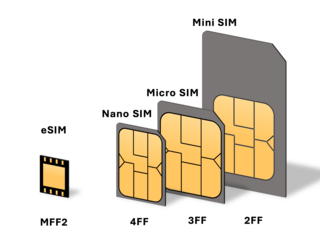Related Research Articles

A SIMcard is an integrated circuit (IC) intended to securely store an international mobile subscriber identity (IMSI) number and its related key, which are used to identify and authenticate subscribers on mobile telephone devices. SIMs are also able to store address book contacts information, and may be protected using a PIN code to prevent unauthorized use.

Near-field communication (NFC) is a set of communication protocols that enables communication between two electronic devices over a distance of 4 cm or less. NFC offers a low-speed connection through a simple setup that can be used for the bootstrapping of capable wireless connections. Like other proximity card technologies, NFC is based on inductive coupling between two electromagnetic coils present on a NFC-enabled device such as a smartphone. NFC communicating in one or both directions uses a frequency of 13.56 MHz in the globally available unlicensed radio frequency ISM band, compliant with the ISO/IEC 18000-3 air interface standard at data rates ranging from 106 to 848 kbit/s.

The International Mobile Equipment Identity (IMEI) is a numeric identifier, usually unique, for 3GPP and iDEN mobile phones, as well as some satellite phones. It is usually found printed inside the battery compartment of the phone but can also be displayed on-screen on most phones by entering the MMI Supplementary Service code *#06# on the dialpad, or alongside other system information in the settings menu on smartphone operating systems.
Cisco PIX was a popular IP firewall and network address translation (NAT) appliance. It was one of the first products in this market segment.

The universal integrated circuit card (UICC) is the physical smart card used in mobile terminals in 2G (GSM), 3G (UMTS), 4G (LTE), and 5G networks. The UICC ensures the integrity and security of all kinds of personal data, and it typically holds a few hundred kilobytes.
In computer security, arbitrary code execution (ACE) is an attacker's ability to run any commands or code of the attacker's choice on a target machine or in a target process. An arbitrary code execution vulnerability is a security flaw in software or hardware allowing arbitrary code execution. A program that is designed to exploit such a vulnerability is called an arbitrary code execution exploit. The ability to trigger arbitrary code execution over a network is often referred to as remote code execution.

A mobile phone feature is a capability, service, or application that a mobile phone offers to its users. Mobile phones are often referred to as feature phones, and offer basic telephony. Handsets with more advanced computing ability through the use of native code try to differentiate their own products by implementing additional functions to make them more attractive to consumers. This has led to great innovation in mobile phone development over the past 20 years.
The Open Mobile Terminal Platform (OMTP) was a forum created by mobile network operators to discuss standards with manufacturers of mobile phones and other mobile devices. During its lifetime, the OMTP included manufacturers such as Huawei, LG Electronics, Motorola, Nokia, Samsung and Sony Ericsson.

Gemalto was an international digital security company providing software applications, secure personal devices such as smart cards and tokens, e-wallets and managed services. It was formed in June 2006 by the merger of two companies, Axalto and Gemplus International. Gemalto N.V.'s revenue in 2018 was €2.969 billion.
SIM Application Toolkit (STK) is a standard of the GSM system which enables the subscriber identity module to initiate actions which can be used for various value-added services. Similar standards exist for other network and card systems, with the USIM Application Toolkit (USAT) for USIMs used by newer-generation networks being an example. A more general name for this class of Java Card-based applications running on UICC cards is the Card Application Toolkit (CAT).
Phone cloning is the copying of identity from one cellular device to another.
The National Vulnerability Database (NVD) is the U.S. government repository of standards-based vulnerability management data represented using the Security Content Automation Protocol (SCAP). This data enables automation of vulnerability management, security measurement, and compliance. NVD includes databases of security checklists, security related software flaws, misconfigurations, product names, and impact metrics. NVD supports the Information Security Automation Program (ISAP). NVD is managed by the U.S. government agency the National Institute of Standards and Technology (NIST).
The term box breaker pertains to the mobile phone industry; where there are companies or individuals that exploit the networks' use of discounts on handsets to create their own profitable business.

Stagefright is the name given to a group of software bugs that affect versions from 2.2 "Froyo" up until 5.1.1 "Lollipop" of the Android operating system exposing an estimated 950 million devices at the time. The name is taken from the affected library, which among other things, is used to unpack MMS messages. Exploitation of the bug allows an attacker to perform arbitrary operations on the victim's device through remote code execution and privilege escalation. Security researchers demonstrate the bugs with a proof of concept that sends specially crafted MMS messages to the victim device and in most cases requires no end-user actions upon message reception to succeed—the user doesn't have to do anything to 'accept' exploits using the bug; it happens in the background. A phone number is the only information needed to carry out the attack.

An eSIM is a form of SIM card that is embedded directly into a device as software installed onto a eUICC chip. First released in March 2016, eSIM is a global specification by the GSMA that enables remote SIM provisioning; end-users can change mobile network operators without the need to physically swap a SIM from the device. eSIM technology has been referred to as a disruptive innovation for the mobile telephony industry. Most flagship devices manufactured since 2018 that are not SIM locked support eSIM technology; as of October 2023, there were 134 models of mobile phones that supported eSIMs. In addition to mobile phones, tablet computers, and smartwatches, eSIM technology is used for Internet of things applications such as connected cars, artificial intelligence translators, MiFi devices, smart earphones, smart metering, GPS tracking units, database transaction units, bicycle-sharing systems, advertising players, and closed-circuit television cameras. A report stated that by 2025, 98% of mobile network operators were expected to offer eSIMs.
Remote SIM provisioning is a specification realized by GSMA that allows consumers to remotely activate the subscriber identity module (SIM) embedded in a portable device such as a smart phone, smart watch, fitness band or tablet computer. The specification was originally part of the GSMA's work on eSIM and it is important to note that remote SIM provisioning is just one of the aspects that this eSIM specification includes. The other aspects being that the SIM is now structured into "domains" that separate the operator profile from the security and application "domains". In practise "eSIM upgrade" in the form of a normal SIM card is possible or eSIM can be included into an SOC. The requirement of GSMA certification is that personalisation packet is decoded inside the chip and so there is no way to dump Ki, OPc and 5G keys. Another important aspect is that the eSIM is owned by the enterprise, and this means that the enterprise now has full control of the security and applications in the eSIM, and which operators profiles are to be used.

Benjamin Kunz Mejri is a German IT security specialist and penetration tester. His areas of research include vulnerabilities in computer systems, bug bounties, the security of e-payment payment services and privacy protection. Mejri is known for uncovering new zero-day vulnerabilities and making them transparent to the public.
BlueBorne is a type of security vulnerability with Bluetooth implementations in Android, iOS, Linux and Windows. It affects many electronic devices such as laptops, smart cars, smartphones and wearable gadgets. One example is CVE-2017-14315. The vulnerabilities were first reported by Armis, the asset intelligence cybersecurity company, on 12 September 2017. According to Armis, "The BlueBorne attack vector can potentially affect all devices with Bluetooth capabilities, estimated at over 8.2 billion devices today [2017]."
eUICC refers to the architectural standards published by the GSM Association (GSMA) or implementations of those standard for eSIM, a device used to securely store one or more SIM card profiles, which are the unique identifiers and cryptographic keys used by cellular network service providers to uniquely identify and securely connect to mobile network devices. Applications of eUICC are found in mobile network devices that use GSM cellular network eSIM technology.

Workz is a technology company specialized in eSIM and cloud-based services. The company is headquartered in Dubai, UAE, and operates worldwide.
References
- ↑ Goodin, Dan (2019-09-12). "Hackers are exploiting a platform-agnostic flaw to track mobile phone locations". Ars Technica. Retrieved 2021-03-15.
- ↑ Cimpanu, Catalin. "These are the 29 countries vulnerable to Simjacker attacks". ZDNet. Retrieved 2021-03-15.
- ↑ Olson, Parmy (2019-09-13). "Hackers Use Spyware to Track SIM Cards". Wall Street Journal. ISSN 0099-9660 . Retrieved 2021-07-28.
- ↑ "GSMA Mobile Security Research Acknowledgements". Security. Retrieved 2021-07-28.
- ↑ "Simjacker – Next Generation Spying Over Mobile | Mobile Security News | AdaptiveMobile". blog.adaptivemobile.com. 11 September 2019. Retrieved 2021-07-28.
- ↑ "Simjacker Technical Paper". www.adaptivemobile.com. Retrieved 2021-07-28.
- ↑ "Virus Bulletin :: Simjacker - the next frontier in mobile espionage". www.virusbulletin.com. Retrieved 2021-07-28.
- ↑ "Simjacker - Frequently Asked Questions and Demos | Mobile Security News | AdaptiveMobile". blog.adaptivemobile.com. 11 September 2019. Retrieved 2021-07-28.
- ↑ "Virus Bulletin :: Simjacker - the next frontier in mobile espionage". www.virusbulletin.com. Retrieved 2021-07-28.
- ↑ Black Hat 2013 - Rooting SIM Cards, 19 November 2013, retrieved 2021-07-28
- ↑ "NVD - CVE-2019-16256". nvd.nist.gov. Retrieved 2021-07-28.
- ↑ "NVD - CVE-2019-16257". nvd.nist.gov. Retrieved 2021-07-28.
- ↑ "GSMA Mobile Security Research Acknowledgements". Security. Retrieved 2021-07-28.
- ↑ September 2019, Anthony Spadafora 13 (2019-09-13). "Simjacker attack could affect a billion smartphones". TechRadar. Retrieved 2021-07-28.
{{cite web}}: CS1 maint: numeric names: authors list (link) - ↑ "Simjacker - VB2019 Presentation" (PDF).
- ↑ "Majority of Simjacker Attacks Aimed at Mobile Phones in Mexico | SecurityWeek.Com". www.securityweek.com. Retrieved 2021-07-28.
- ↑ "New SIM attacks de-mystified, protection tools now available". www.srlabs.de. Retrieved 2021-07-28.